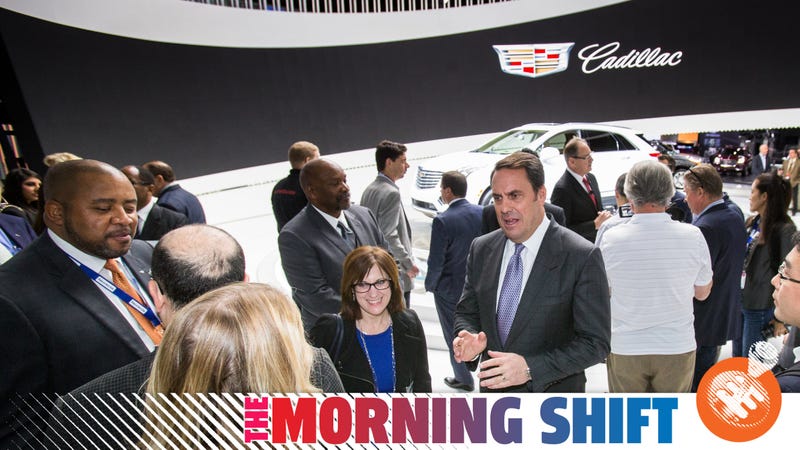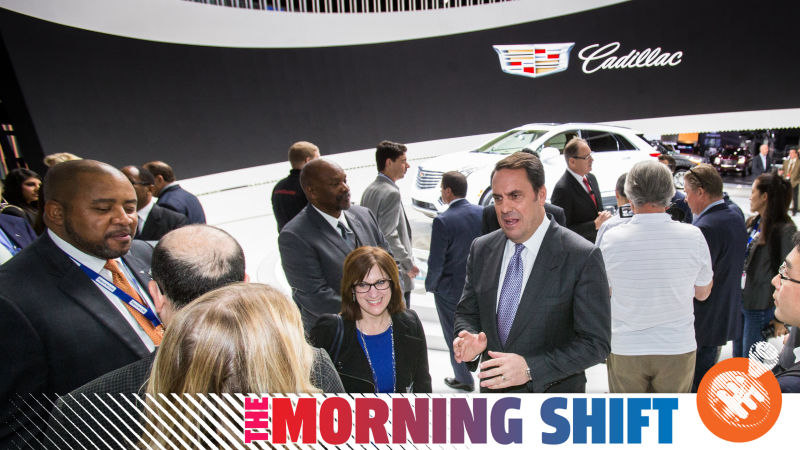
 The Morning ShiftAll your daily car news in one convenient place. Isn’t your time more important?
The Morning ShiftAll your daily car news in one convenient place. Isn’t your time more important? Cadillac’s “futures” strategy remains vague, TomTom is in the news once more and Hyundai’s winning streak. All of that and more in The Morning Shift for Wednesday, Sept. 4, 2019.
1st Gear: Have You Seen Cadillac Lately?
Here at Jalopnik, we’ve made no secret over how baffled we are over Cadillac’s current strategy. It moved its headquarters back to Michigan, sure, but then it’s also positioning itself rather confusingly.
The new XT6 doesn’t look great, the XT4 has arrived to middling reviews across the board, and the new V-cars don’t put out the huge horsepower numbers we’ve come to expect. That’ll happen later, supposedly, but it’s not a great look for now.
Advertisement
In an interview at this past Detroit Auto Show, Cadillac president Steve Carlisle gave us a vague and sometimes confusing look into how the luxury American automaker is betting on its brand power to attract buyers, its failure to implement Super Cruise across more models and how it just launched an unnamed EV rendering in 2019, while its competitors are well on their way to bringing EVs to market.
We weren’t the only publication to question the automaker, so General Motors president Mark Reuss penned a reactionary op-ed in Automotive News he claims “[sets] the record straight with Cadillac.”
Advertisement
It opens familiarly with, “When people ask me if we’re working on the future of Cadillac, I say, “We’re working on the Cadillac of futures.””
He continued:
Even as we work to get there, we remain laser-focused on the flurry of activity around Cadillac today. Some recent media reports, including in this publication, have questioned Cadillac’s strategy and neglected its progress.
Cadillac’s modern brand identity is well established, and we are building an arsenal of products and technologies that will differentiate Cadillac and take it to the next level in the marketplace, despite the slings and arrows of the pundits and naysayers. In fact, by every critical measure — sales, quality, dealer engagement and customer satisfaction — Cadillac is making great progress.
Advertisement
Do tell!
Most important, we are launching an onslaught of new vehicles. You’ll see a new Cadillac car, crossover or SUV just about every six months, on average, through 2021. At that point, Cadillac dealers will have new products in segments that represent 90 percent of U.S. luxury market sales.
Momentum continues to build in 2019. Cadillac retail sales rose about 4 percent in the second quarter, led by our expanded SUV lineup:
- Since being launched last year, the XT4 quickly became and remains the bestselling vehicle in the segment.
- Escalade remains No. 1 with a bullet in large luxury SUVs, despite nearing the end of its life cycle. It has an 8,000-unit lead over its nearest rival while delivering significant profitability for our dealers.
- XT6 deliveries began in June, and we sold more than 1,000 units in July before its August media launch. We expect it to do even better based on the largely positive reviews, despite a hotly competitive segment and recent reports to the contrary in this publication.
Advertisement
This op-ed sounds nearly verbatim to the interview Carlisle gave to me: We are Cadillac, we will offer more crossovers and SUVs (because Cadillac dropped the ball on that one) and we will offer class-leading technology and so on and so forth. All promises made in the future tense. Plus drawing attention to the existing lineup that’s… fine. Absent of class-leaders except maybe the Escalade.
Anyway, it’s rare that Automotive News would really bite back at any automaker ever, but it did drop a wonderful own in an editor’s note that concluded Reuss’s piece:
Editor’s note: The Automotive News Data Center classifies the XT4 as a compact premium crossover, and it was the No. 5-selling nameplate in the segment in the first half of this year in total sales. GM places the XT4 in a different category, and Reuss’ comments refer only to retail sales.
In addition, an earlier version of this editor’s note regarding the Cadillac Escalade’s ranking in the premium SUV segment did not include sales of the Escalade ESV nameplate. Again, Reuss’ comments refer only to retail sales.
Advertisement
That’s pretty brutal, but then again, going to a trade publication aimed at car dealers to defend your brand decisions is… weird? Does Mercedes do that? Does Lexus?
2nd Gear: Yes, TomTom Is Still Around
I read Bloomberg’s headline, saw the name “TomTom” and immediately did a double-take. TomTom is still around? And people are talking about it? What year is this??
Advertisement
For those of you who didn’t use one, TomTom is a company that developed and created satellite navigation systems for consumers if their car didn’t come with one and before anyone really had a smart phone. I just assumed TomTom quietly went out of business when Google and Apple Maps-enabled phones became mainstream, but it didn’t. Bloomberg just reported it’s very much still around and betting big on self-driving cars.
From the story:
Now the Dutch digital mapping company is betting that your car needs directions more than you do. Over the past few years, TomTom has been building high-definition or “dynamic” maps for self-driving cars. It’s a decision that could help it challenge tech platforms, like Alphabet Inc.’s Google, as cars are increasingly sold with more autonomous capabilities.
“We used to make maps for humans, but now we make maps for robots,” Alain De Taeye, member of TomTom’s management board, said at a journalist briefing in Amsterdam.
Advertisement
TomTom has stiff competition coming from Apple, Google and HERE, which is BMW’s digital mapping company when it comes to car navigation. The outlet reports Renault, Nissan and Mitsubishi, which used to be TomTom’s partners, jumped ship to Google’s Android operating system last year for standard definition maps.
Instead, TomTom is turning toward HD maps, which are extremely important when it comes to self-driving systems.
HD maps, stored on a car’s computer system, replicate every lane, guard-rail, road edge and pole that a vehicle sees, helping cars locate their positions within centimeters. Those features are critical to avoid crashing into nearby cars, but they also help the car discern which traffic light at a busy cross-section it should obey or identify a speed sign hidden by a truck.
So far, TomTom has publicly announced HD partnerships with Baidu Inc. on its Apollo driverless project, and with Renault on the carmaker’s SYMBIOZ autonomous driving program. It announced in March that it had won multiple deals to provide HD maps to major car makers, but declined to say which ones. Those contracts, which typically last more than 10 years because of ongoing service needs, have so far resulted in a roughly 60% market share in HD maps for TomTom, according to Willem Strijbosch, the company’s head of autonomous driving.
Advertisement
And here I was, thinking for years TomTom was gone. It was never gone. Maybe just a little… lost.
3rd Gear: Hyundai Is Doing Well
It’s not my imagination the Korean automakers have been on a roll recently. They consistently scorewell in the J.D. Power rankings (if you follow such things) and their cars are generallywell-favoredby the Jalopnik staff. August marked Hyundai’s 13th straight month of year-over-year gains, reports Automotive News.
Retail volume increased 11 percent in August, Hyundai said, marking the sixth time in the last seven months that the brand achieved year-over-year retail sales growth. Hyundai, along with Kia, were also among the few automakers to reduce incentive spending in August, according to ALG data. (See chart below.)
Retail deliveries of Hyundai crossovers totaled 34,844, a monthly record, with sales of the subcompact Kona rising 34 percent. Hyundai said August sales of the new three-row Palisade crossover topped 5,000, exceeding company targets.
Advertisement
Congratulations, Hyundai. See what happens when you build good cars that people actually want to buy? They buy them! Who would have thought!
4th Gear: Thousands Of Mercedes GLEs Just Sitting Around
There are thousands of Mercedes-Benz GLEs sitting, waiting, at a German airport, which is the most I have ever identified with an inanimate object. I, too, am familiar with the feeling of just sitting motionlessly at an airport while people more important than me get their shit straightened out. But whereas my woes generally stem from air traffic, the GLE bottlenecks are from supplier issues that are delaying deliveries.
Advertisement
The cars are lined up “in blocks,” with some 15 across and seven deep, “stretching down the tarmac at the former Ahlhorn airport near the city of Bremen,” reports Bloomberg. The cars are supposed to be bound for the U.S. and other parts of Europe.
From the story:
The company has issued four profit warnings in little more than a year, most recently in July, when the company included a “slower model ramp-up” as one of the reasons for cutting its full-year guidance. At that time, Chief Executive Officer Ola Kallenius highlighted issues with the company’s SUVs on a quarterly earnings call. Problems with a supplier in the U.S. caused production bottlenecks, Kallenius said at the time.
A Daimler spokeswoman detailed supplier problems after the simultaneous launch of the revamped GLE in several markets and a jump in output at the plant, leading to delays in getting the cars to customers. Demand for the vehicles remained strong, she said. Mercedes uses storage sites around the world to temporarily park cars, such as when they await shipment. This includes the former Ahlhorn airport that’s currently used for a range of Mercedes models, she said.
Advertisement
GLEs, GLEs everywhere. If you wanted one and don’t have it yet, this may be why.
5th Gear: Subsidies: Good?
Electric car sales get helped along by government subsidies, but what happens when you scale the subsidies back? Then electric car sales fall, too. As much as I want to think EV sales are driven by people wanting to do a little good for the environment, it’s probably all closer tied to money.
Advertisement
After China cut back on government purchase subsidies for electric cars in June, global EV sales fell “for the first time on record” in July, reports Bloomberg.
From the story:
Monthly sales worldwide fell 14% to about 128,000 plug-in passenger electric vehicles, Sanford C. Bernstein said in a report Tuesday. Sales declined in China and North America, while rising in Europe.
While electric vehicles account for just a few percent of the car market, automakers are betting on the segment for future growth. Slowing demand for gas guzzlers has plunged automobile markets worldwide into a decline, led by a historic drop in China.
Advertisement
Experts, however, still believe the long-term trend in EV sales is positive and this is just a blip. I sure hope it is. With so many cities across the world implementing gasoline and diesel bans within the next few decades, people won’t really have a choice soon.
Reverse: Jaaaaaaaag Is Born
British automaker Jaguar wasn’t always named Jaguar. It was founded in 1922 and was originally named the Swallow Sidecar Company:
The Swallow Sidecar Company, later to be renamed Jaguar, was founded by William Lyons and William Walmsley with guarantees of £500 each.
Advertisement
Neutral: Would You Buy A Cadillac?
Would you buy a Cadillac merely because “it’s a Cadillac”? Or is that not a reason enough?













